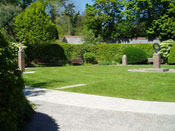
Return to Co. Dublin list

Go to Prehistoric Alignments & Dials

Go to Ancient Monastic Dials

Go to Medieval Dials

Go to Modern (1600+) Dials

Go to Sundial Info.and Books

Return to Co. Dublin list |
 Go to Prehistoric Alignments & Dials |
 Go to Ancient Monastic Dials |
 Go to Medieval Dials |
 Go to Modern (1600+) Dials |

Go to Sundial Info.and Books |
 Sandymount Strand Sundial |

Sandymount Strand |
Sandymount Strand is a large sandy beach on the south side of Dublin Bay
on the east coast of Ireland. In 1983, to celebrate the birthday of the Irish writer James Joyce, a pair of granite sculptures were erected in the Irishtown Sean Moore playing fields at the northern end of the Strand. In Joyce’s ‘Ulysses’, Leopold Bloom walks towards Dun Laoghaire, along Sandymount Strand, hence the choice of site. And in ‘Finnegans Wake’ Joyce coined the word ‘Quark’ which is used by scientists to describe an elementary particle and fundamental constituent of matter. The sculptures were commissioned by the Dublin History Workshop, who were approached by the artist, Clíodna Cussen, with the idea of making a sun aligned stone monument on the foreshore of the Strand. |

Marker stone An Gallán Gréine |
The piece was inspired by the clear view of the sunrise during the winter solstice from this point on the beach and consists of two elements. The largest, 4.3 metres high, is called An Gallán Gréine [The Sun Pillar] and resembles a massive single open-quotation mark An Gallán Gréine has equation designs on its sides, which were inspired by Dr Ian Elliott of Dunsink Observatory who helped with the alignment of the stones. One of the equations shows the coming together of matter as provided by Dr Theodore Garavaglia from the Dublin Institute of Advanced Studies. Nearby is a low, 0.6 metre high name stone engraved ‘AN GALLÁN GRÉINE do JAMES JOYCE’ [THE SUN PILLAR for JAMES JOYCE]. |

An Clog Gréine |
The other stone, An Clog Gréine [The Sundial ] is a 1.5 metres high Polar Sundial located about 150 metres north west of An Gallán Gréine. To view the Winter Solstice alignment : on the mornings around the 21st December stand at An Clog Gréine and as the sun rises over Killiney Hill it will be seen to be in line with the distant Gallán Gréine and the name stone. |

An Clog Gréine |
An Clog Gréine is a 'Polar Sundial'. Common garden sundials have a horizontal dial plate with a triangular gnomon (the shadow caster which is set at the latitude of the location) and the hour lines radiate from the root of the gnomon. A 'Polar Sundial' has the plate face inclined at the latitude of the place with the gnomon vertically on the 12 o'clock hour line. Its upper edges and face are parallel to the dial plate and the hour lines are parallel to each other and the gnomon. |

Hour Lines on a polar dial NOTE the noon gap to compensate for the gnomon thickness |
The hour lines run 7-8-9-10-11-12 then 12-1-2-3-4-5.The morning hours are indicated
by the receding edge of the shadow, the afternoon by the advancing edge.
Noon occurs at the instant when the shadow disappears and then reappears from under the gnomon. Watch time differs from sundial time by approximately 1½ hours during the summer, ½ in the winter. Click here for my explanation as to why they differ |